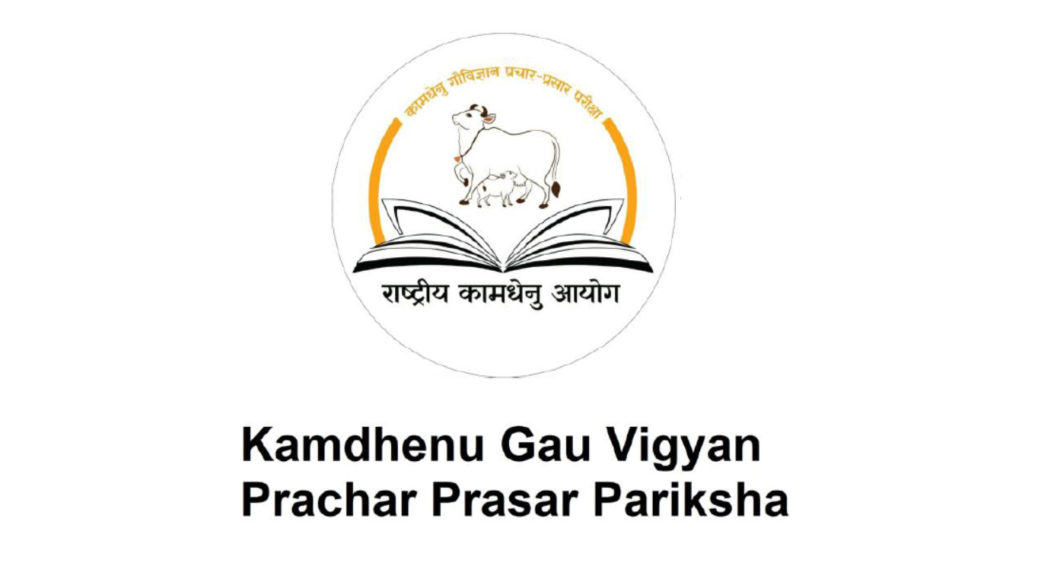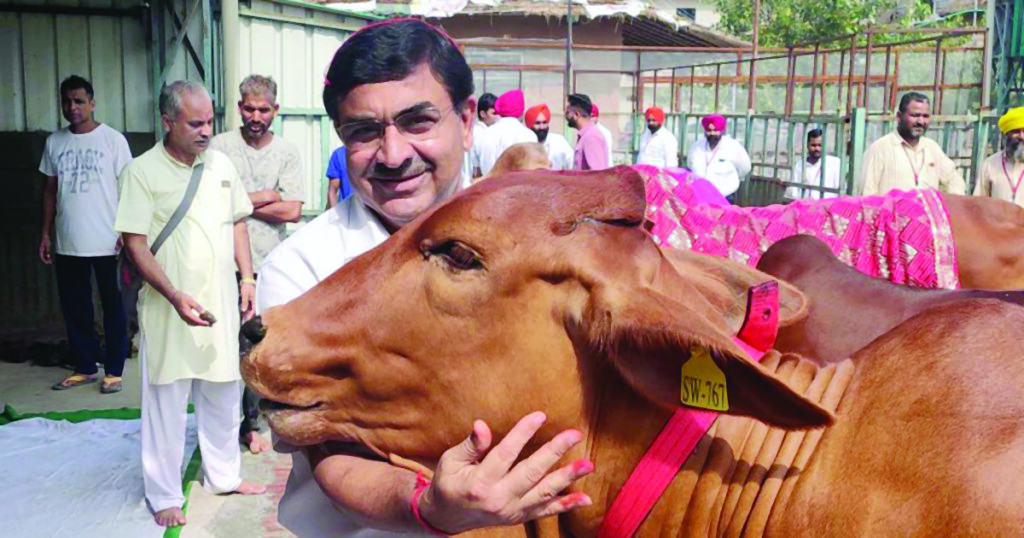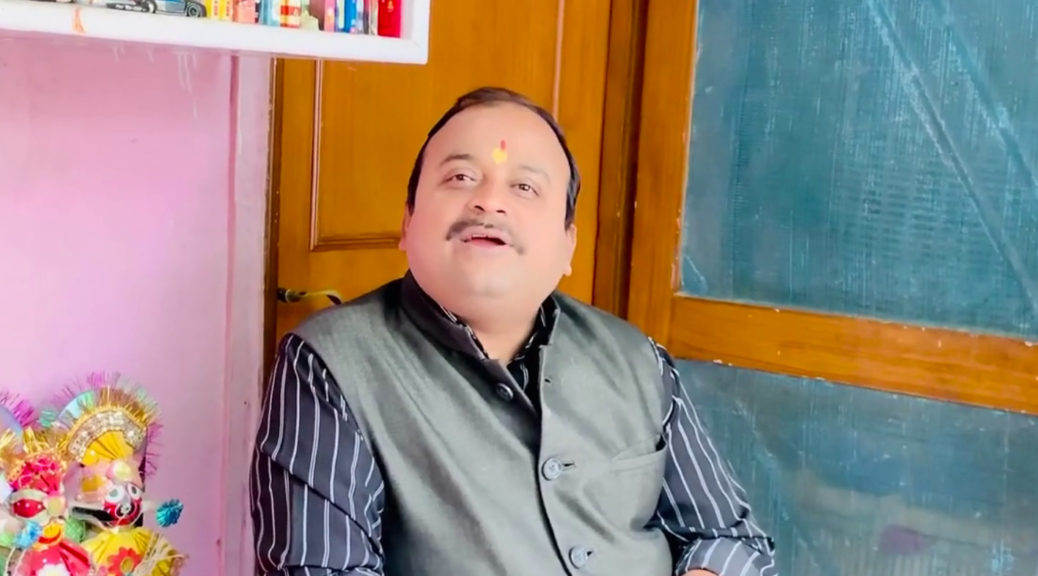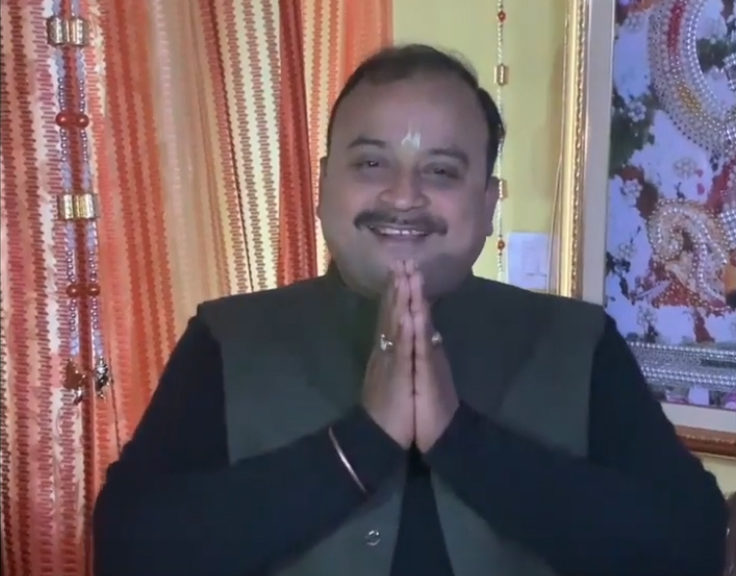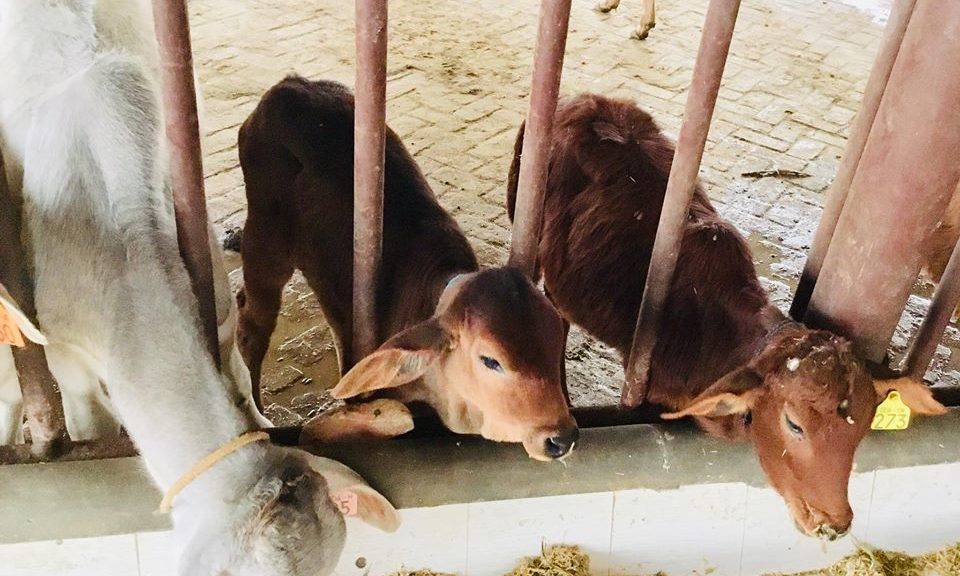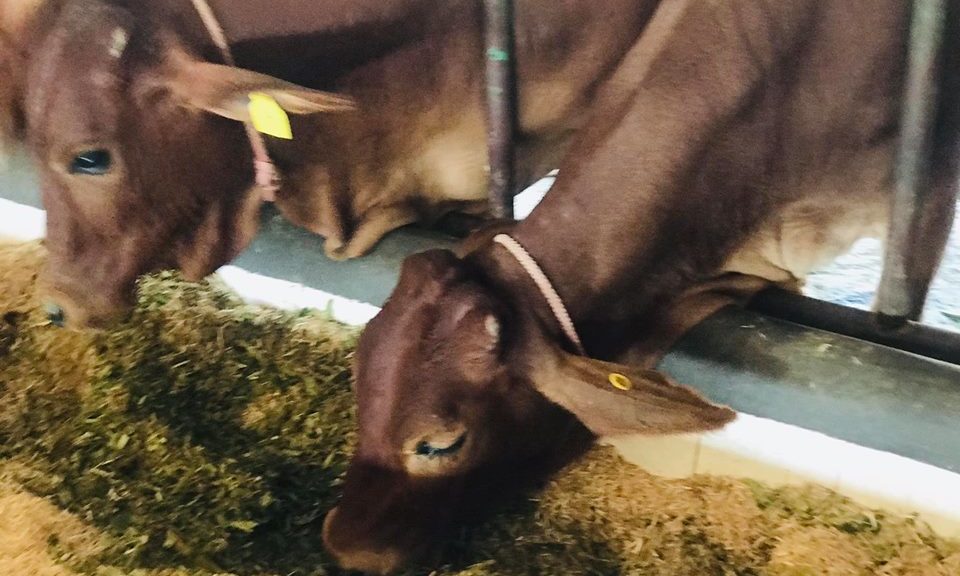Cows are held in higher regard than other animals in India. Some consider them holy, and deserving of protection not only from cruelty but also from activities, which would be considered routine in the West, such as slaughter for consumption and for leather goods. The cow’s special status in India is enshrined in law. With the exception of two states, the slaughter of cows and calves is totally forbidden, whatever the reason and at whatever age. Bulls and bullocks and she-buffaloes are protected up to 15 years of age. But all this apparent reverence and protection masks a trade in cows and cow products which involves unbelievable barbarity and cruelty. Much of the abuse stems from the fact that the trade in, and slaughter of cows is almost entirely clandestine and illegal – but the authorities which should be stopping it are routinely bribed to let it continue. There is, therefore, no scrutiny or regulation of the trade anywhere along the line. Laws enacted in various Indian states reflect a variety of opinions, and cattle slaughter is permissible in some and not in others. This means that cattle that are set for slaughter must be transported from places where they are, to the states where cow slaughter is permitted.
The story of the annual smuggling of an estimated 1.5 million cattle says much about modern India– about the sometimes hypocritical treatment of supposedly sacred cows and the corruption that allows the $455-million (according to some estimates) illegal trade to flourish. But ultimately this story is about supply and demand. Hindu-majority India has an estimated 280 million cows but killing and eating them is legal in only a handful of states. Meanwhile, Muslim-majority Bangladesh, where beef is eaten with relish, suffers from a shortage of cattle. Half of the beef consumed in Bangladesh comes from its large, western neighbour. The snaking border that divides the two countries runs for 1,300 miles or roughly 4,096 kilometers. The illegal movement of cattle consisting of only cow and its progeny (no buffaloes) via land and water from India to Bangladesh is an old standing problem that has been going from bad to worse. Cattle-smuggling is flourishing, particularly from Assam and West Bengal, so much so, that beef processing and leather units have been established along the border in Bangladesh.
The cattle smuggling from West Bengal to Bangladesh across Indo-Bangla border is taking new routes and new masks. There is a slump in the volume of trafficking thanks to vigil and active campaign by Border Security Force (BSF). Officers of the BSF, whose jawans patrol the 915- km stretch of the border that West Bengal shares with Bangladesh, estimate that cattle smuggling has come down by more than 70 per cent since the NDA government at the Centre made the issue one of its top priorities. In April last year, Union Home Minister Rajnath Singh instructed BSF personnel deployed along the border to check cattle smuggling.
Four months later, the minister touted the drop in figures for cattle smuggling as one of the government’s major successes: from about 20-22 lakh cattle that would be smuggled across the border every year, he said, the numbers had come down to 2-2.5 lakh cattle in 2015.
Since the BJP-led government came to power, the BSF has given its men discretionary powers to shoot at cattle smugglers, a strategy that has reportedly contributed to the drop in smuggling. In December 2015, in a written reply to a question in the Rajya Sabha, Minister of State for Home Kiren Rijiju had said, “During the current calendar year, 21 cross-border criminals were killed by the BSF along the Bangladesh border, of whom 16 were allegedly cattle smugglers.”
Interestingly, price of beef in India is Rs 150, while it is more than double in Bangladesh, Rs 350. With the recent slump in the smuggling and resultant demand-supply gap, the beef price has skyrocketed, making trafficking riskier but much lucrative. The economics of the whole operation is found to be quite lucrative enough for people to ignore the risks to life. At least 60,000 cows are used to be smuggled into Bangladesh every day at various points along the 4,096.7-km long border, although there is no real way to corroborate those figures. For last 2-3 years cow smuggling in North Bengal especially through Cooch Behar and Alipurduar district have been increased spontaneously and due to inactivity of police administration. Also involvement of powerful political leaders behind the curtain has added extra strength to such criminal activities. Cow theft cases in those districts have reached to the peek due to the inaction of police. Mostly Bangladeshi Muslims are involved in cow theft cases and cow smuggling as reported by the affected local public.

The Modus operandi in South Bengal
The cows are being brought from Rajasthan, Haryana, Uttar Pradesh,Odisha, Bihar, Jharkhand to two major haats – Pandua and Mograhaat in Chinsurah subdivision and Mayapur in Arambagh subdivision. They are being loaded on trucks. The trucks move along Nadia Iswar Gupta Setu, Kalyani Barrackpore Expressway to reach Nilgunj, Jessore Road to reach border point Bongaon.
Some cows come to Haringhata and Birohi haat. The other route is Kalyani,NH34, Chakdah, Chakdah-Bongaon Road. With stricter vigilance, they are now entering Bangladesh through Tetulia. The other border used is Angrail border. Angrail has a unique topography of being a thumb-shaped land mass surrounded from three sides by the Icchamati River which flows into both the countries.
In Bangladesh the price for beef is Rs 12,000 – 14,000 per quintal. Bigger cows from Haryana and Rajasthan are normally 2.5 to 3 quintal in weight which means one cow, sometimes, costs Rs 50,000 which is a lucrative deal. Apart from this fact, sticks sharpened at one end are used by these men to poke the cattle and infuriate them if the BSF does indeed turn up. A dah (long thick dagger native to the area) is also carried for extra protection. In recent times, country-made pistols are also in use along with crude bombs. Men who cross the border to hand over the cattle known as Ghorupaatis, stay illegally in Bangladesh until noon and then simply walk or take a train back home in broad daylight, cocking a snook at the security forces in both the countries.
The modus operandi in North Bengal
There are two kinds of routes in North Bengal which the smugglers use for cattle rustling. In north Bengal the majority of cattle are being smuggled across 172 km long border that Malda district shares with Bangladesh. The cows come from distant places like Gujarat, Punjab, Uttar Pradesh and Bihar. Majority of these cows come to Gonda Cattle Haat in Jharkhand. From here the consignment comes to Sahebgunj. From there the cattle are taken to Hamidpur Char via Rajmahal. From there the cattle consignment goes to Baishnabnagar to Murshidabad’s Nimtita. Alternatively, the consignment moves from Rajmahal to Dhuliyan and Pakur. At Pakur, the cows are stamped with specific number.
From here, it takes riverine route (Malda shares 30 km riverine border with Bangladesh). The cows are bound one after another by long iron-chain. They are then taken to the Ganga by some hand-picked youths called Rakhals, known for their swimming skills. They then take the line of cow along the riverine route to Bangladesh. Since cows are naturally very good swimmers, such smuggling happens at night. For facilitating the smuggling of each pair of cow, a Rakhal takes Rs 3,000.
 The cattle reach the Chapai at Nababgunj in Gomostapur police station area in Bangladesh. Documents of ownership are made here before taking to different slaughter houses in Bangladesh.
The cattle reach the Chapai at Nababgunj in Gomostapur police station area in Bangladesh. Documents of ownership are made here before taking to different slaughter houses in Bangladesh.
The second route is entirely through land border. From Jharkhand, it goes to Shamshi Ghat and from there to Ratanpur Haat, Habibpur Haat, Harischandrapur, Kedariparaa, Kutadaha, Songhat. Since a huge stretch of Indo-Bangla border is without fence, smuggling is easy. The cattle are smuggled across to Pengabari, Naogaon, Rohanpur Slaughterhouse.
But what Delhi sees as ‘rustling’, Dhaka sees as legitimate cross-border trade. So during the November 16-17 last year Home Secretary-level talks between the two countries, Bangladesh raised the issue of rising prices of beef in that country as a result of the BSF crackdown. Dhaka allegedly also requested Delhi to “go easy” on cattle smugglers. The BSF has identified 64 Border Outposts (BOPs) along the Bengal-Bangladesh border that are vulnerable to cattle smuggling. Of these, they say, 46 account for 80 per cent of the cattle smuggling casesThe BSF’s outposts are mostly bamboo sheds where jawans spend the nights. In the mornings, these outposts see a steady stream of people who take their cattle to the other side to graze. The jawans greet the cattle herders, reminding them to be back before sundown. Cattle smuggling instances have gone down by over 90 per cent this year in this area. This area constitutes for 80 per cent of this illegal activity comprising districts of North 24 Parganas, South 24 Parganas, Nadia, Murshidabad and Malda. BSF has innovated low cost solutions like digging ditches and improvising fence security by welding GI pipes about 2-feet above the ground, BSF official claims that it has shown very good results in checking the illegal activity. The border guarding force, over the last five months, has plugged some of the most vulnerable patches of this 4,096-km border by not only increasing troop strength but also providing them with more weapons, vehicles and a fresh fleet of fast attack motorboats to patrol riverine areas.
For decades, the smuggling and sale of cattle across the border have provided sustenance to families in these areas. The trade has thrived, often as a family profession, with secrets passed down generations: how to evade the BSF, the best routes to transport cattle, how to ensure stealth while crossing the border. The economics of cattle smuggling is what makes it more lucrative for families on both sides of the border. For most Indian farmers, a cow past its prime is of little value. Besides, tractors have long replaced bulls and oxen and they are of little use too. So the cattle are sold to traders who supply them to slaughterhouses in India, both legal and illegal. But with beef selling for around Rs 350-Rs 450 a kg in Bangladesh, in comparison to Rs 150 a kg in Bengal, cattle rustling is far more lucrative. Thus is the unholy business of the cows.
By Nilabh Krishna
How to light a communal fire
 The Superintendent of Police of Khurda is not a face for me, just a voice, that too faint, literally and metaphorically. I have not met Mr Dilip Das, but in the last two years, a group of us have called him up 350 times, which makes it an average of once in two days. In the beginning, he took one out of five calls; in four months, from mid-September 2015 to January,he answered only three of my 50 calls. I call him so often because I am very fond of myself, precisely, my human status.
The Superintendent of Police of Khurda is not a face for me, just a voice, that too faint, literally and metaphorically. I have not met Mr Dilip Das, but in the last two years, a group of us have called him up 350 times, which makes it an average of once in two days. In the beginning, he took one out of five calls; in four months, from mid-September 2015 to January,he answered only three of my 50 calls. I call him so often because I am very fond of myself, precisely, my human status.
In keeping with this, I have taken it upon myself to rescue the gentle cows, the delicate calves, the hardy bullocks and the majestic bulls—right out of the clutches of the cattle-smuggling/slaughter mafia. Khurda, the district in Odisha, of which Das is the chief law-keeper — along with Bhadrak in Odisha– is the hub of the cattle-smugglers. My practical identity: Honorary Animal Welfare Officer with the Animal Welfare Board of India( ANBI) and volunteer, Gau Gyan Foundation, an NGO, deeply into the rescue and rehabilitation of cattle.
To set the record straight, I started this long before there was even a hint of the saffron party coming to power and before the idea of India was re-defined by a foreign news agency that equated the right to eating beef with the right to food and freedom of choice. How the idea was fuelled by some pseudo-humans is, by now, history. Maybe, one day, an alter ego of Romilla Thapar would literally illuminate that side of India’s history in which hurting other life forms even through the breath is an avoidable human error.
Such is the evil grip of misinterpreted history that a Sanjiv Marik, despite being Director General of police, likes to open his mouth big about his knowledge of ancient Indian history, in which he says there was no bar on beef-eating, while he keeps his ears firmly shut to the talk of the Orissa Prevention of Cow Slaughter Act and the Prevention of Cruelty to Animals Act.
Police-Criminal Nexus
Marik gave lilting support to the cattle mafia as chief of police in Odisha until last November—through sins of omission– but it was I who heard the sweet music: Marik was forced to go on leave, then, given a punishment posting as head of Orissa State Road Transport Corporation and is now probably retired. Marik’s less-than-dignified exit from the office of DGP had apparently nothing to do with his covert support to the cattle mafia, but I exhaled deeply: To an El Capone victim, it does not matter whether the blue-blooded gangster was at last caught over a white collar crime like tax evasion, as long as he was caught.
Before I am accused of criticising the ex-DGP of Odisha unduly, let me say that I have said the same thing in a petition to the former chief justice of the Orissa High Court, Amitava Roy, and in a written complaint to the present Environment Minister. Copies of these were also officially routed to Marik through the AWBI a few months before his exit, and when a 21-year-old volunteer personally showed them to him last July, Marik laughed them off. The same Marik had fumed when I asked him for police protection for cattle rescue work. He asked me to collect all the stray cattle of Odisha and take them to Delhi. This was in the September of 2014.
The crooked part of this remark was that he was trying to negate the seriousness of this highly organised crime, worth trillions of rupees, with the Odisha police playing a key role in it. Odisha is a converging point of cattle smuggled from four states– Andhra Pradesh, Telangana, Jharkhand and Chhattisgarh. Aided by the police, each day and night, pick-up vans, trucks and sealed containers speed along NH 5 and NH 6 to reach the slaughterhouses of West Bengal and Bangladesh.
I also have pictures of other big vehicles stuffed with cattle: an emptied out luxury air-conditioned bus, a milk van, a train bogey and an Indian Oil container. So far, in my knowledge, the only means of transportation the smugglers have not used is the aircraft. Given the benevolence of some of our wealthy and internationally-connected artistes, thinkers and politicians, who knows, we might hear of a plane load of bulls being carted for a beef party!
Alarming Statistics
Pre-Eid, the smuggling through north Odisha goes up from an average of 4,000 per day to 5,000 plus/day. Almost an equal number goes to Andhra and Telangana from the south of the state. I can say this on oath in court—and I did through a Public Interest Litigation (PIL No 4238) in the High Court of Orissa–but all hell breaks loose when I quote these statistics to the top cops. From being accused of indulging in ridiculous exaggeration to being called a nit-wit, I have faced everything.
The only people who would not dare deny it are the junior cops—from those of the Begunia police station in Khurda to Khantapada Police Station in Balasore– because it is they who manage the networking of the illegal business. My fellow volunteers in every district along the east coast of Odisha have a list of the names of cops, musclemen, smugglers and the middlemen who are part of the racket.

Quite a large number of these are Hindus. In fact, I personally know some who spew venom against the cow-killers in public and take money from the smugglers on the sly—for facilitating the truck movement. The cop conduits also know what we rescuers do. Though healthy cows, calves, bulls and bullocks, a majority of them of the choicest Indian breeds, are in high demand in the beef markets abroad. They are smuggled from West Bengal into Bangladesh, from where they are exported to the middle-east and Europe.
The cattle-smugglers, posing as traders, buy them in thousands at the weekly cattle markets organised in every nook and cranny of India, a majority of them illegal. As part of rescue work and evidence-gathering, I have visited scores of them in Karnataka, Andhra Pradesh and Odisha.
Political Patronage
I got two cattle markets shut down officially, one in Begunia (Khurda, Odisha) where the Biju Janata Dal government has the devil-may-care attitude towards the cow protection laws and the other in Karhi Bhadar (Balod, Chhattisgarh) where the Bharatiya Janata Party government has the holier-than-thou approach.
 The shutting down of a cattle market does not, however, mean an end to the crime of smuggling/slaughter. As long as the police and the administration are with the mafia, the illegal business goes on uninterrupted. In both Begunia and Karhi Bhadar, the illegal business is still thriving.
The shutting down of a cattle market does not, however, mean an end to the crime of smuggling/slaughter. As long as the police and the administration are with the mafia, the illegal business goes on uninterrupted. In both Begunia and Karhi Bhadar, the illegal business is still thriving.
When I first landed in Begunia in October of 2013, there were just three or four major hubs of the cattle mafia. Today, there are more than what I can count. Each one of these is known to the SP, the Begunia police station cops and to the volunteers.
I have sent a couple of faxes and many SMSs to Das, requesting him to raid these illegal dumping yards in order to nip the crime in the bud. Better still, he can prevent the collection of cattle at these places. He dismisses my messages with silent contempt. He does not believe me and my fellow volunteers about the statistics of smuggling: the Khurda-based smugglers contribute at least 40 per cent to the 1.25 lakh cattle trafficked from Odisha to West Bengal every month.
Sometimes, we are lucky to get the truck numbers in advance. I sent Das a list of 65 truck numbers on September 13, 2015. He, as a rule, asks me and other callers from Delhi for the “exact location” of the illegal holding areas. The local volunteers are ever-ready to escort the police to these places, but Das snubs them bitterly.The junior cops keep slapping false cases against them.
Justice Delayed
Given the police support to the mafia, the volunteers also don’t get entangled in FIRs and court cases. My own experience with the courts has been punishing. The 358 cattle I rescued in Kusupullah under Begunia PS in 2013, were given in the custody of village sarpanch Bulla Swain in violation of the law, and from the sarpanch to the mafia that took them for slaughter within no time. In the court, the police showed the cattle as “Stolen”. I dragged my heels in the Khurda district court for 45 days over this. Not having got justice, I went to the High Court of Orissa, where the case is still pending—after two long years.
But the rescue work has given me an insight into ground politics, how the police fail us rescuers and how they aid the criminals. I have also encountered dramatically diverse views on the cow-smuggling/slaughter issue. It is the most lucrative business for Hindu traders and Muslim smugglers, just another animal for the beef-eaters,who neither know nor care to know whether it is against the law, an object of vengeance for some fundamentalist Muslims who cannot expend their bile against the Hindus through other means and a perfect front for the Hindu fundamentalists to let out their steam against Muslims.
Divine Bovines
For the vast and silent majority of seculars, Hindus and Jains, however, the cow and the bull are pieces of divinity they love from the core of their hearts. This silent majority of people, across the boundaries of region, gender and age, suffer deeply when the cow and family are hurt. Their tears and smiles are linked to those of the cows, bulls, calves and bullocks they hold dear. They are also enraged at the open police support to the smugglers and killers of cattle.
The police, especially at the top, are either in denial of the crimes against cattle or afraid to touch this “communally sensitive” issue. By now, I know what this term means: there is a large number of Muslims in this illegal trade, some of them are dreadful dons. If there is a police raid on their dens, they would hit back. The Hindus in the neighbouring places, forever charged about the cow issue, would be provoked and the police would have a communal riot on their hands.
In the face of such arguments, I simply cannot push the envelope about animal welfare law-keeping. Giving this reasoning, the police have kept themselves—and me–off at least a hundred places all over the country, from the Kasai Gali in Belgaum and a slaughterhouse on the highway in Bailhongal (both in Karnataka) to Sakshigopal, Balipatna, Balasore, Bhadrak and Khurda in Odisha.
Studied Silence
Repeated pleas to the Khurda SP to nip the crime of cattle-smuggling in the bud have gone unheard. Today, Kadab is a communal tinderbox. On December 27, 2015, the police were informed hours before the smuggling of cattle happened at midnight. The Khurda SP did not do anything. The Begunia police did not reach the spot. Two trucks, cruelly stuffed with 121 cattle, which itself is enough to enrage any rescuer, were caught by the villagers. Many cows died of sheer suffocation. By the time the trucks were driven to the Begunia Police Station and a complaint was booked, it was the afternoon of the next day (FIR No.194/15 Begunia PS).
The cattle were given back to a hoax animal welfare activist. We filed a case (G.R. Case No 1416/15) in the Khurda District Court about the bungling done by the Begunia police. My coordination from Delhi ended with this case. I know about the rest of the story of communal tension build-up from the volunteers and a study of the FIRs, which, for a change, were booked thick and fast by the Begunia PS.
The story goes like this: The cattle mafia, that suffered a loss of at least 60 lakh rupees because of the seizure of cattle and trucks on December 28, hit back and brutally beat up a few volunteers after laying a trap through their Hindu ‘friends’. This happened on January 12 post-midnight. The boys, whose phones had been snatched, who hid in thick bushes all night, reached the Begunia police station the next morning, were shocked to see that a complaint had already been filed against them by the smugglers. The mafia’s false complaint, FIR No. 3/16, on January 13 was filed at 2 A.M. and that of the genuine victims, FIR No. 04/16, in the late evening of January 13.
This brutal assault and the police foul play forced the Hindu volunteers to lie low and stay off rescue work, but on February 9, 2016, they got a chance to square up. After rescuing five cattle being smuggled in a pick-up van, they thrashed the smugglers. Since the police have a record of giving the cattle back to the mafia, the rescuers did not bother to file a complaint. Later, the smugglers kidnapped two Hindu boys and locked them up in a masjid. Only the intervention of an elderly Muslim, the Hindus say, saved the boys.
Eyeball-to-Eyeball
On the morning of February 10, about 300 Hindu men went to the house of the Muslim smuggler, armed with sticks and rods, but did not find him there. The other side, they claim, set fire to a barn and accused the Hindus of having lit it. This invited several serious cases against 80 Hindu men. Before this incident, the police refused to book a complaint against an accomplice of the smugglers who, the Hindus claimed, stamped on a Shivling in a temple and posted his picture on the social media. I too have this picture. For ten long days, this issue kept the two sides in Kadab village locked in negotiations on how to end the smuggling of cattle and how to live in peace with each other.
On February 20, a notorious middleman, named Battapani, visited the village to persuade the Hindus to call a truce. His idea of it was to make the Hindus look away from the crime of cattle-smuggling. Earlier, Battapani, himself a Hindu, had delivered death threats to cow-rescuers over the phone on behalf of the Muslim smugglers. I heard him–for 58 long minutes on a conference call in the last week of February—sweet talk to a volunteer about the need to “compromise” with the smugglers. The volunteer, like the rest of the Hindus, would brook none of this talk. As of now, there is an impasse.
The Muslims against whom cases have been booked, even if they are arrested, have no worry because the Khurda police and the money bags of the smugglers are with them. The Hindus know that if the 80 odd people, against whom false cases have been booked, go to jail,not only will they rot there but the volunteers who do lawful cattle protection in Khurda would also be muzzled.
On the morning of February 21, I was told, the mango and cashew groves of a couple of Hindus were burned down as revenge for the loss of livelihood that the freeze on cattle-smuggling means for some Muslims. As of now, there is an eyeball-to-eyeball situation between the two sides. Armed police were posted in the village and the District Collector organized a peace meeting, which was too little, too late. There is simmering tension in Kadab, and it is spreading. In the rest of Khurda, cattle-smuggling is in full swing.
On March 2, 2016, some people in Lodhachua village, 12 kilometers from Kadab, caught a bolero stuffed with five cows, untied the cows, let them loose, beat up the smugglers and did not bother to inform the police. When I made contact with one of them and told him not to take the law into their hands, he shot back: “Are you out of your mind to be asking us to seek police help?” I had no answer.
Kadab is on the brink of a full-fledged communal war–entirely on account of the crime of cattle-smuggling that the Khurda police stubbornly refuse to check. The build-up has been slow, steady and systematic. What I find shocking is this: in the times of a Dadri lynching and an Agra rally (Muslims warned of ‘final battle’ at the Sangh meet/Indian Express story/ Feb 29, 2016), can the police anywhere in the country afford to ignore the crime of cow smuggling and slaughter, much less aid it through sins of commission and omission as the Khurda police are doing? This is a question that the SP of Khurda must be made to answer.
By Jagpreet Luthra

